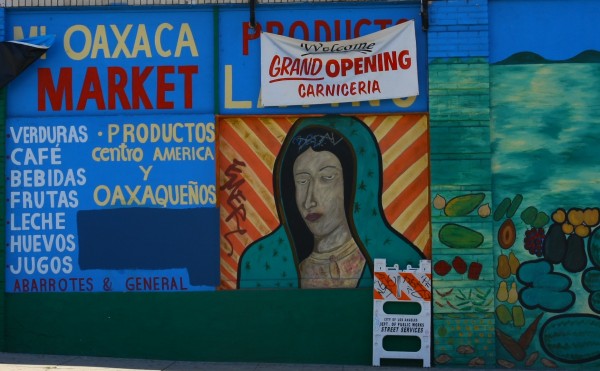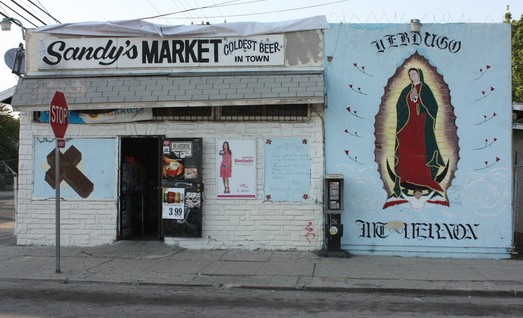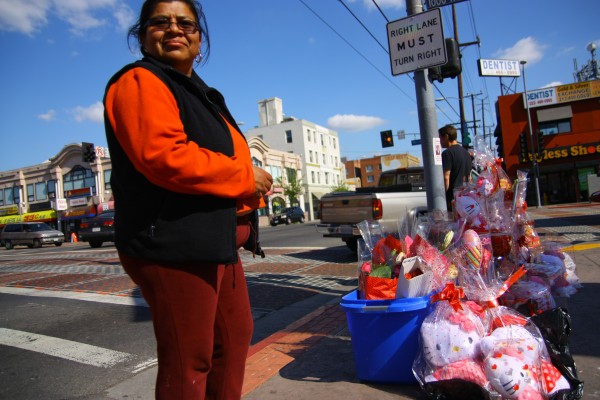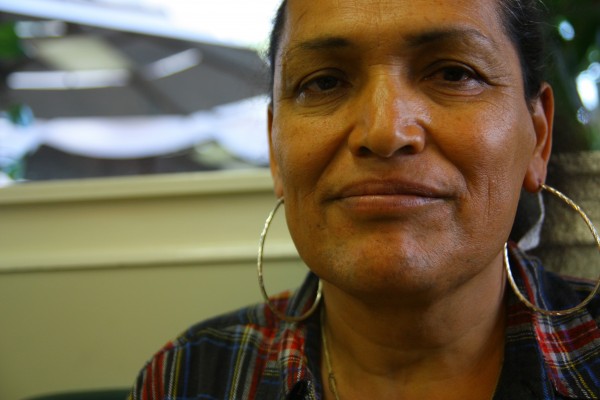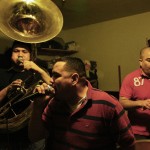STREETS: Virgin of the Carniceria
Filed under Los Angeles, Migrants, Streets, Virgin
STREETS: `It’s like Vietnam around here’
Earlier today, I was covering the aftermath of the shooting/fire in East Hollywood that took the lives of two people (the shooter being one) and left four people wounded Thursday afternoon. (Here’s the LAT story)
I was leaving when I was approached by Sherman Werner, the self-proclaimed “only Anglo for three miles around,” which I believe, as East Hollywood is largely Central American, Mexican (Oaxacan mostly), Filipino, Thai and others.
Mr. Werner, turns out, lived in Porter Ranch then sold his house and moved into an apartment building he owned seven years ago, a few blocks from the fire/shooting.
One of the interesting parts of LA scenery are the last remaining Anglos in areas that have gone through enormous demographic change and are now largely immigrant communities. From these folks, whom I’ve occasionally come across, you’re likely to get a highly unvarnished view of things.
Mr. Werner was no different, commenting on the women, the numbers of murders — “One there, one next door to me, now this one, and they’re all about infidelity.” He was wearing no shirt — of course not. he’s 71. who’s he got to impress any more? — and his dogtags from his Marine days.
In 1965, he was drafted, on Lyndon Johnson’s birthday and sent to Vietnam,which he compares to the neighborhood where he now resides. “I haven’t seen this much action since the Vietnam War,” he told me.
He had choice words for the MS gang whose graffiti we saw a few yards away. He had that horse laugh of a long-time smoker, and showed me where he’d taken shrapnel. I hardly had to do any talking.
Filed under Los Angeles, Migrants, Southern California, Streets
GANGS: Where’d all the gangs go?
Not long ago, I was in the West Side Verdugo and Mount Vernon neighborhood of San Bernardino. An old barrio dating to the 1920s, it has long been home to several gangs.
Yet when i was out there, there was no gang graffiti on the walls. I saw none. A few years before I’d done a story on an upcoming trial – a notorious gang killing known as the Dead Presidents case, for the murder of two charismatic brothers who presidents of their respective gangs. The graffiti was there.
This time, I spoke to an old lady and she told me the “the OGs told everyone to stop. That it was bringing heat. The kids can’t do it no more.” This was largely due to a gang injunction the county had brought against several gangs in the area, according to this lady.
Southern California is in the midst of a radical shift in gang behavior. No longer do you see gangs on the street, hanging out, commandeering liquor stores or parks the way they used to.
They still exist, and are still deadly, but mostly they’re not as public. My impression is that there are fewer of them, too. So the classic expression of gang culture that LA has been famous for and exported to many parts of the US and other countries is distinctly fading. I’ll be reporting on this occasionally, as I believe it’s a big deal.
There are a few reasons for this. Gang injunctions, whatever their constitutionality, have forced them indoors. Greater penalties for graffiti seem to be another factor. I think in some cases gangs have teamed up with drug traffickers from Mexico who aren’t interested in working with cholos with tattoos on their faces and baggy pants fighting with rivals over territory and who’ll bring police heat. So dress codes are changing; so, too, are spats over this kind of territory that once were the reason for being for a lot of gangs.
One place they’ve gone, as this AP article from Elliot Spagat makes sadly clear, is Central America.
Filed under Gangs, Los Angeles, Streets
CULTURE: Tijuana Opera’s upcoming season
The Opera de Tijuana has announced the first of its events for this upcoming season.
They include Madame Butterfly on May 18 and 20.
Also thrilled to see that the company will continue with what has become one of the truly fabulous arts events in Mexico: the Opera Street Festival.
It takes place on July 7 on Calle 5 in Colonia Libertad, likely the world’s most unexpected place to hear opera. (I wrote about this in my second book, Antonio’s Gun and Delfino’s Dream. There’s an NPR report I did on the topic with my MC homey Franc Contreras producing, as well.) You can see the border wall from the stage and the singers compete with the graffiti and the old American cars rumbling by. Expect 7000+ people.
A real event.
The city’s opera scene has a cool story behind it, involving a group of Russians musicians imported by one music-obsessed Tijuanense in the early 1990s — but that’s a long story and one I’ll tell later, or which you can read in my book.
STREETS: More on transgender style and Latinas
I love my job. Yesterday I was talking with Brenda Gonzalez, a transgender woman from the state of Michoacan, who works in Hollywood. I’d gone to her nonprofit service agency because they host a meeting of Latina transgender women every Wednesday.
Anyway, we were talking more about the case of the transgender woman, Nathan Vickers (or Cassidy, or Chassidy), who was murdered in November and again the topic turned to how Latina immigrants, mostly from Mexico, had changed transgender culture.
As I’ve written here in an earlier post, Latinas dove into surgery in a big way. Part of it, Brenda told me, was due to the fact that they were illegal and had no work and street was all that was available and guys with large breasts, high cheeks, round buttocks made more money. It was also because many came looking for a transformation that was denied them in Mexico — much like other immigrants, from small, benighted villages.
“Part of the transition is transforming yourself emotionally, spiritually, and physically. You have to be beautiful, up to date, you have to look beautiful, sexy, voluptuous,” she told me.
But with so many girls in the same situation, all competing on the street, “part of the competition becomes obsession. You see some little Lupita on the corner with a new nose, then you want one. If she gets a nice bust, you want one, and now not just size 40, but 44dd.”
Plus, their world is very small, she said. “I live in East LA but I hear when someone in Hollywood gets an operation. If I live in Hollywood, I hear when someone Long Beach gets operated or someone in Van Nuys gets a sex change.” So that adds to the demand for surgery.
Most important are breast implants. Breasts being the most obvious sign of being female, implants are the transgender’s American Dream, Brenda said.
“Part of the transition and acceptance and feeling happy and content with ourselves, what makes us feel even more secure and more like women, is when we have breast augmentation. It’s why most of us have our breast surgery. Some view it from the sex market: There’s more demand for those who have them, and then you can then get more surgery and send money home to mom and dad. It’s a fundamental part of the transition that make you feel secure are implants, breast surgery that gives you a large and beautiful bust. It’s part of your own feeling of security. It’s essential.”
Man, you just don’t hear this kind of stuff that often.
Sorry no photos from the interview. So here (above) are a few when I lived with the girls in Mazatlan as they prepared for what was then the oldest gay beauty contest in Mexico (from my first book), including one who is getting her breasts injected with baby oil, which was the only method they could afford on the money they made hooking down in Mazatlan.
Filed under Los Angeles, Mexico, Migrants, Streets
CULTURE: More photos from Los Cenzontles, David Hidalgo, Jackson Browne recording session
- David Hidalgo and Jackson Browne
- David Hidalgo and the Hammond organ
- Jackson Browne
- David Hidalgo
Filed under Culture, Los Angeles
CULTURE: Cenzontles with David Hidalgo and Jackson Browne
This weekend I spent time in a recording session with Los Cenzontles (the Mockingbirds), along with David Hidalgo, of Los Lobos, and singer-songwriter Jackson Browne, as they recorded the band’s new CD, Regeneration.
An amazing time. Many thanks to Eugene Rodriguez, of Los Cenzontles, for inviting me. I’d never watched a record get made, let alone with two of my musical heroes. We had chats about music, about immigration, New Orleans and Bob Dylan. They now all have my book. :\) Read on, guys!
Los Cenzontles are an amazing story. The brainchild of Eugene and Astrid Rodriguez, they’re a Mexican roots band that spawned a youth center in San Pablo, near Berkeley, and which in turn spawned an expansion of the band.
Cenzontles now have several CDs out and have played with other roots music heroes of mine – Ry Cooder and Taj Mahal, in particular.
I felt a little dazed to be around these guys. Jackson Browne’s Late for the Sky was one of the soundtracks to my 1970s and his voice remains once of the most distinctive in pop music, I think. (He also has the good taste to continue to play with Claremont’s own master instrumentalist, David Lindley; their Love is Strange CD is very greasy.)
Los Lobos were the band I listened to most in the 1980s. Hidalgo is a deeply musical cat, I always thought, and his tenor voice remains one of the greatest in rock n roll. (For the coolest grungy garage band tune, listen to Georgia Slop.)
I turn to both guys’ music often.
The three songs they recorded sounded like the best of good music — sweet and raw: Adios California, a ranchera in Spanish, The Silence, an elegant song about the drug violence in Mexico, with a sweeping vocal by David Hidalgo, and Jackson Browne adding the harmonies; a third song, collaboration among the band, Browne and Hidalgo, is about the border, which Browne is singing, but isn’t finished and is untitled. Still, so far, it sounds great.
The band will be raising money to complete the album and I’ll post more when they do. Hopefully, by then they’ll have a chunk of The Silence I can put up. Either way, can’t wait to listen to Regeneration.
Meanwhile, what’s your favorite song by any of these guys?
Filed under Culture, Los Angeles, Southern California
MEXICO: China meets Mexico
Check out these cool shots from photographer Keith Dannemiller in the latest edition of Americas Quarterly.
Filed under Uncategorized
LOS ANGELES: Valentine’s sales
I was coming out of an interview this afternoon and headed to lunch when I came upon a vendor named Maria, from the town of Mitla, Oaxaca, selling Valentine’s flowers and gifts at Santa Monica and Western.
We had a long chat, after I bought some flowers. As festive as Maria and the women selling with her looked, Valentine’s Day to them was less about love than desperation.
After 25 years in the United States, working as a maid, Maria told me she’s been without domestic work for months. Her construction-worker husband is down to only a couple days work in the best of weeks.
So a few days ago, she and a battalion of women went downtown to the Toy District for Hello Kitty dolls. She spent the next few days assembling Hello Kitty Valentine’s packages, and was now selling them from between $10 to $20 each. Then, she went to the Flower District downtown, bought flowers in bulk, and put them together in bouquets for $20 apiece.
“I really haven’t done this before, and it doesn’t make a lot of money, but what else do I have,” she told me, standing at the busy and sun-splashed corner Tuesday afternoon, surrounded by women, unemployed maids, just like her and selling the same kind of stuff.
Reports are that the economy is returning. Remittances to Mexico from immigrants in the United States are up. Maria and her friends at Santa Monica and Western don’t see it.
A friend, who gave her name only as Magdalena, pointed to a 99-cents store on Santa Monica that closed and was replaced recently by a swap meet, which she helped open. Still, “there’s just no business,” said Magdalena, an unemployed maid and a migrant from the tourist resort of Acapulco.
Maria figured to be out selling until 6 pm, hoping to get rid of the flowers and Hello Kitty dolls she bought. She’s worried, though, because Friday her landlord filed eviction papers from the house she and her husband have rented for 18 years and raised her four children when they couldn’t pay the rent on time. they’d been late before, apparently, and it appears this time her mother fell and required stitches, so the rent had to wait.
“We’re thinking of going back home,” she told me as I was leaving.
Filed under Los Angeles, Mexico, Migrants, Streets
MEXICO: Lynching
Brutal story here from Milenio newspaper coming out of a small town near Mexico City: townspeople lynched three guys, apparently construction workers from a nearby town.
Townspeople apparently believed they’d tried to kidnap two youths. A mob burned two of them inside their car. Another died at a hospital.
In this story, 23 people — including six women and three minors — were arrested for the lynching.
Lynchings have occurred for years in Mexico; I wrote about one in my first book, True Tales from Another Mexico: The Lynch Mob, the Popsicle Kings, Chalino and the Bronx. I have a file in my archives 3 inches thick of clippings of lynchings.
Unlike the lynchings in the US South, they are usually the bellow of working people who perceive, rightly or wrongly, that a crime against them is going unpunished and possibly that the criminals have protection from above. This may be the case. But sometimes, as in the case I wrote about in the state of Hidalgo, people misunderstand some remark, the word spreads, a match is held to the inflamed passions of already aggrieved people and they get together and take justice into their own hands, victimizing innocent folks.
Lynchings happened frequently in Indian communities where people are accustomed to coming together for self-protection.
Don’t know what the case is here.
Filed under Mexico
LOS ANGELES: Solitary Virgin
Here again, another in my attempt to photograph every Virgin of Guadalupe in South LA.
This one was just off Compton Boulevard, painted on what had once been a payphone casing.
If you have photos of the Jefa you’d like to put up, please send them in — doesn’t matter where from….
Filed under Culture, Los Angeles, Mexico, Migrants
STREETS: Latinas and transgender style
As I wrote earlier, I’ve been doing a story on the murder of a transgender black woman named Nathan Vickers, who also went by the names Chassidy, Chase and Cassidy.
I believe homicide gives reporters an opportunity to write about how a person lived, and less about how she died. As part of that, I’m trying to write about the transgender prostitute subculture in Hollywood.
One person I talked to was Luisa Rivera, a transsexual who has lived here for many years and who comes from Guadalajara. Latina transgenders changed a lot about the culture, which was really about drag queens until they arrived. They began coming in large numbers in the 1980s, mostly from Mexico, she said. As it happened, this coincided with the emergence of plastic surgery, which kept dropping in price as the years passed.
Far more so than other groups, Latina transgenders went for plastic surgery in a big way, she said. Enormous breasts, cheek and buttock implants, lots of silicon and hair weaves. Rivera said. In Hollywood they had surgeons here and in Tijuana to choose from. (They also had a vast, monied john clientele here, who insisted that they remain “fully functional” men, as the back-of-the-book ads in Hollywood sex throw-aways relentlessly put it.)
As we spoke, it occurred to me that Mexican transgenders were very much like other Mexican immigrants, but with a twist.
Mexican immigrants, generally, have spent the first dollars they’ve earned here in establishing themselves back home, mainly by building large houses. So it’s not only a house; it’s a way of showing everyone else how the person has done, that he is no longer the humble, shoeless kid who left the village at 15, who was humiliated for simply being poor. His transformation is complete.
Mexican transgender women also come here for a transformation — wanting to live as women after years of beat-downs and humiliations. They, too, want to show success publicly and quickly. Instead of houses, they spend on their bodies, to show the world, and maybe themselves, that they are not who they were when they were run out of their hometowns and country. Their breasts especially are monuments (pardon the pun, if that’s what it is) to the person they have become and always wanted to be back in Mexico.
Very much enjoying this story. More interviews to come.
Filed under Los Angeles, Mexico, Migrants, Streets
CULTURE (kind of): SNL spoofs tuba thefts
This is getting weird. SNL’s Weekend Update riffed off the stolen tuba story last night. Here’s the full show, check it out at minute 35 or so.
As it happens, I missed it. By weird coincidence, I was out last night at a rehearsal of a banda of guys calling themselves Los BuKnas de Culiacan (that would be a bastardization of Buchanan, the rum), in a garage in Downey (see photos above). Buchanan Rum is a prized drink in the Mexican narco world — a sign of class and having arrived.
One of the songs was “Si No Vienes Conmigo” — which involves a man threatening his girlfriend that if she doesn’t come with him, he’s going to kidnap her and not charge a ransom. Where’s the romance gone?
Actually the band is a mixture of banda and norteno — with tuba, baritone horn, plus accordion — and looks to me a lot like the beginnings of punk rock. Went to the club where they were playing after the rehearsal and they wouldn’t let me and two BBC colleagues in. Reporters strictly prohibited at El Potrero Club in Cudahy.
Filed under Los Angeles, Mexico, Migrants, Uncategorized
STREETS: Sgt. Dwight Waldo
One joy of journalism is the distinctive people you meet. Sgt. Dwight Waldo is among them.
I’ve gotten to the know the good sgt, out of San Bernardino PD lately. He is a national expert on tagging — those incomprehensible graffiti scrawls, often mistaken for gang graffiti. You see it on overpasses or warehouses or flood channels.
The kids who do it possess a drive bordering on obsession for scaling astonishing heights to paint their monikers — and thus achieve Mt. Everest-like renown among the tagger underground. One crew Waldo knew had its smallest member practice painting upside down so they could hang him from his ankles over freeway overpasses to paint their crew name.
Waldo has spent most of his career studying and arresting kids who do this. He’s written a book, taught classes to cops — all about kids who will do almost anything to get to impossible-to-reach places to then paint, etch their names.
A few years ago, Waldo, as a respite from this bleak world, took up music. With a drive bordering on obsession, he learned instruments, six in all.
He now plays his music (violin and bagpipes mostly) in the most astonishing places: strolling his neighborhood (see photo above), atop a rock at Gettysburg, in front of the Queen Mary or the Alamo, and on the roofs on countless hotels.
The similarities here to the taggers he pursues is, of course, not lost on Sgt. Waldo, who sees a little of the kids in the challenge he presents himself of finding the most out of the way, unexpected places to play his Scottish reels and Civil War waltzes.
Story drops in a few days. Had such fun doing it. Like tagging, and his music itself, Waldo was an unexpected find.
Filed under Southern California, Streets

